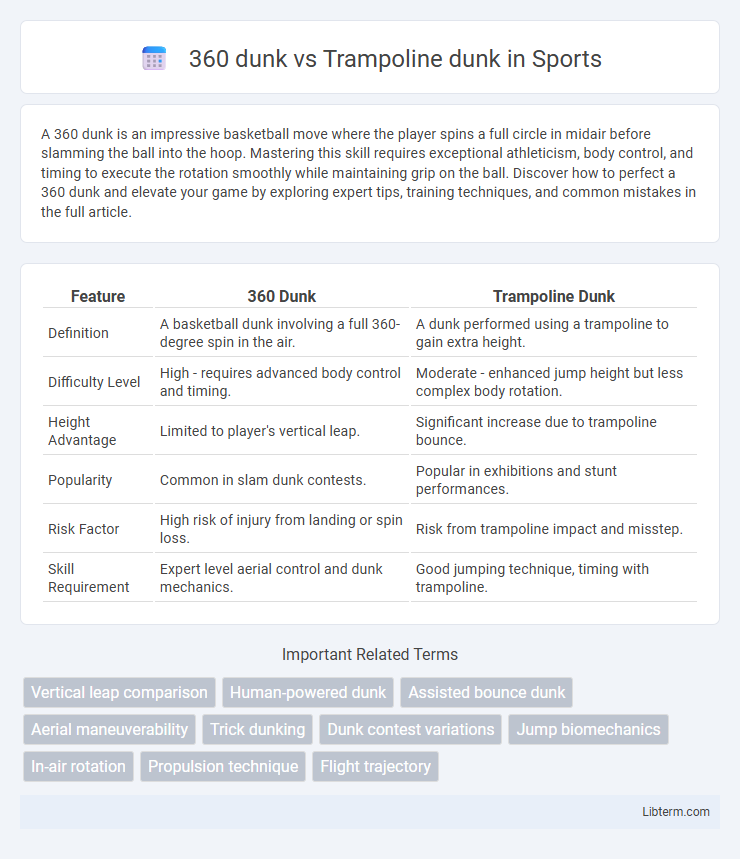A 360 dunk is an impressive basketball move where the player spins a full circle in midair before slamming the ball into the hoop. Mastering this skill requires exceptional athleticism, body control, and timing to execute the rotation smoothly while maintaining grip on the ball. Discover how to perfect a 360 dunk and elevate your game by exploring expert tips, training techniques, and common mistakes in the full article.
Table of Comparison
| Feature | 360 Dunk | Trampoline Dunk |
|---|---|---|
| Definition | A basketball dunk involving a full 360-degree spin in the air. | A dunk performed using a trampoline to gain extra height. |
| Difficulty Level | High - requires advanced body control and timing. | Moderate - enhanced jump height but less complex body rotation. |
| Height Advantage | Limited to player's vertical leap. | Significant increase due to trampoline bounce. |
| Popularity | Common in slam dunk contests. | Popular in exhibitions and stunt performances. |
| Risk Factor | High risk of injury from landing or spin loss. | Risk from trampoline impact and misstep. |
| Skill Requirement | Expert level aerial control and dunk mechanics. | Good jumping technique, timing with trampoline. |
Introduction to 360 Dunk and Trampoline Dunk
A 360 dunk involves a player completing a full rotation in the air before slamming the basketball into the hoop, showcasing advanced athleticism and body control. In contrast, a trampoline dunk utilizes a trampoline to gain extra height and momentum, allowing for more dynamic and often higher-reach dunk variations. Both dunks emphasize different skills: the 360 dunk highlights rotational agility while the trampoline dunk focuses on explosive vertical leap enhancement.
Defining the 360 Dunk: Technique and Appeal
The 360 dunk is a basketball maneuver where the player completes a full 360-degree spin in midair before slamming the ball into the hoop, showcasing exceptional body control and aerial awareness. This technique demands precise timing, strong core strength, and advanced jumping ability, making it a thrilling spectacle in dunk contests. Its appeal lies in the blend of athleticism and style, offering a dynamic visual display that captivates audiences and elevates a player's dunking repertoire.
Understanding Trampoline Dunking: Basics and Variations
Trampoline dunking involves jumping on a trampoline to gain extra height and momentum for executing powerful slam dunks, enhancing vertical leap and aerial control. Variations include the basic trampoline dunk, 360 trampoline dunk, and double or triple flips combined with dunks, which require advanced coordination and timing. Understanding key elements like bounce technique, body positioning, and follow-through is essential for mastering trampoline dunks and minimizing injury risk.
Skill Level Required: 360 Dunk vs. Trampoline Dunk
Executing a 360 dunk demands advanced athleticism, precise body control, and spatial awareness to complete a full rotation mid-air while maintaining ball control. In contrast, a trampoline dunk leverages enhanced vertical height provided by the trampoline, reducing the level of body control and rotation skill required but still necessitating timing and coordination. Overall, the 360 dunk requires a higher skill level due to the complex rotation and dunk combination without external assistance.
Athleticism and Training for Each Dunk Style
The 360 dunk demands exceptional body control, core strength, and coordinated rotational power, making plyometric training and rotational drills essential for mastery. Trampoline dunks emphasize explosive leg strength, precise timing, and aerial awareness, often requiring specialized rebound training to maximize vertical lift. Both dunk styles benefit from targeted strength conditioning, but the 360 dunk prioritizes rotational agility while the trampoline dunk focuses more on vertical explosiveness.
Safety Concerns: Risks and Precautions
360 dunks involve more complex aerial rotation, increasing the risk of awkward landings and potential ankle or wrist injuries compared to trampoline dunks, which offer stable bounce control but still pose risks of falls and collisions. Protective gear such as padded mats, wrist guards, and proper footwear are essential to minimize injury during both types of dunks. Adequate training, supervision, and warm-up exercises reduce the likelihood of muscle strains and joint stress when performing 360 or trampoline dunks.
Audience Impact: Which Dunk Is More Impressive?
A 360 dunk captivates audiences with its full rotation, showcasing advanced body control and athleticism that highlight a player's skill and creativity in mid-air. Trampoline dunks, enhanced by the extra bounce, allow for higher elevation and often wow spectators with seemingly effortless height and powerful slams. Audience impact depends on the setting: a 360 dunk impresses in standard gameplay with its technical difficulty, while trampoline dunks dominate in exhibitions or dunk contests by amplifying visual spectacle and gravity-defying feats.
Performance Settings: Street, Gym, or Entertainment
360 dunks require advanced skill and are best suited for gym or street settings where ample space and firm ground provide optimal performance conditions. Trampoline dunks excel in entertainment venues and gym environments equipped with trampolines, enhancing height and showmanship. Street performances favor 360 dunks for their technical appeal, while trampoline dunks dominate in controlled, entertainment-focused settings for dramatic visual impact.
Notable Athletes and Iconic Moments
Notable athletes like Vince Carter have popularized the 360 dunk with his gravity-defying moves during the 2000 NBA Slam Dunk Contest, creating iconic moments that still inspire fans. Trampoline dunks gained fame through athletes such as Slam Baller Marcus Hammond, who used the trampoline's bounce to execute spectacular dunks on televised SlamBall games. Both dunks have left indelible marks on basketball culture by showcasing extraordinary athleticism and creativity that energized audiences worldwide.
Final Comparison: Which Dunk Dominates?
The 360 dunk showcases advanced aerial control and rotation, demanding significant athleticism and skill, while the trampoline dunk leverages explosive height for dramatic flair and power. In the final comparison, the 360 dunk dominates in technical complexity and style among basketball purists, whereas the trampoline dunk captivates audiences with sheer vertical elevation and spectacle. Evaluating dominance depends on whether precision or showmanship holds greater value in the dunk's context.
360 dunk Infographic

 libterm.com
libterm.com